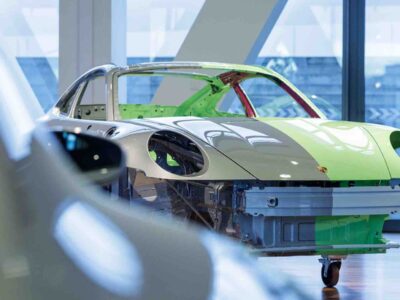For over a century, Harley-Davidson has been synonymous with motorcycles, but now they have turned their two-wheel expertise to electric bicycles. This spring, the Milwaukee-based company is launching a set of four e-bikes to great anticipation and glowing early reviews.
Well, actually, these e-bikes technically aren’t branded as Harley-Davidsons, but as Serial 1 Cycle Company – but more on this naming later. First, let’s talk about these electric bicycles and see why gearpatrol.com has hailed the Serial 1 as “the best-looking E-Bike we’ve seen.”
The initial Serial 1 models are named: Mosh/Cty, Rush/Cty, Rush/Cty Step-Thru, and Rush/Cty Speed. The first three are Class 1 bikes (pedal-assist only with a 20 mph max speed) while the Rush/Cty Speed is a Class 3 (pedal-assist only with a 28 mph max speed). The Mosh, which is being billed as an “urban play bike,” is the most basic model; however, it is far from basic.
The Mosh, like the Rush models, are powered by a Brose Drive S Mag mid-drive motor that features an ultra-quiet belt reduction as well as an electronic torque sensor connected to the pedals (meaning a throttle isn’t required for push-off). Additionally, the motor contains four modes (Eco, Tour, Sport, and Boost) that balance power and battery economy.
All Serials 1s also come stocked with hype standard features including a frame-integrated lithium-ion battery; a cleverly hidden belt tension system; premium Schwalbe Super Moto-X tires and a sleek, lube-free single-speed Gates Carbon Drive belt drive system (instead of a chain that is more commonly used).
The single-speed carbon drive belt system is one of the e-bike’s several nods to its motorcycle roots. The same team behind Harley-Davidson’s LiveWire electric motorcycle developed the Serial 1’s battery. Both the battery and the motor are mounted low on the e-bike’s frame – similar to how they are on a motorcycle – and this design improves the e-bike’s handling and cornering. The battery comes in two capacities: 529 Wh (for the two standard Cty models) and 706 Wh (for the Step-Thru and Speed models).
While each Serial 1 e-bike has a lightweight Harley-Davidson-designed hydroformed aluminum frame, the Rush models boast unique racks and fenders and an elite encased, maintenance-free automatic Enviolo NuVinci transmission, which makes for a smooth ride.
Early praise has not only noted the high-quality elements of Serial 1’s motor and frames, but also the attention to detail that further enhances the ride experience. The integrated LED lighting runs front to back, with tail lights embedded on both sides of the rear triangle; brake lights triggered by a built-in accelerometer; a bright “seeing” light built into the handlebar mount, and a powerful “be-seen” headlight that boasts broader beam than typically found on e-bikes.
Another design highlight is the built-in storage space, which is perfectly sized for an Abus folding lock. Smart details extend all the way to custom washers to reduce fender and rack noises; paint marks on the hydraulic disc brake calipers allow for visual check for loosened bolts; and a high-quality multi-purpose tool that can be used on any of its bolts and nuts. There will also be a Bluetooth-compatible app that will provide data and other functions for the rider.
These well-designed elements, both large and small, serve to distinguish Serial 1 models. When comparing these e-bikes to their premium-priced rivals like Specialized and Trek, Micah Toll, in his review for Electrek, states “the difference is you also get all of the extra details from Serial 1. Toll revs up his praise, proclaiming “these e-bikes have been through more stringent design and testing than any other e-bike I’ve seen.”
Serial 1 is entering a rather crowded market that already includes some big-name vehicle companies (such as Jeep, Ducati, and Audi). While Serial 1 e-bikes aren’t inexpensive (they run from $3399-$4999); their prices do fit in with their competitors: BMW’s e-bike prices begin at $2250 while Porsche’s start around $7,000.
So why did Harley-Davidson spin-off its e-bike division as Serial 1? H-D had been working on e-bikes for several years. They even presented prototypes at the 2019 EICMA Motorcycle Show in Milan. Covid-19’s economic repercussions, coupled with several down years in motorcycle sales, made the company rethink its e-bike project. Instead of scuttling it, Harley-Davidson let the e-bike team spin-off as a separate company with H-D as its large equity holder.
The Harley ties remain prominent. Serial 1 is an homage to the name of Harley-Davidson’s first motorcycle: “Serial Number One.” Besides being located on H-D’s Milwaukee campus, Serial 1 also operates out of the same building that housed the Harley-Davidson race shop from the 1950s into the early 2000s.
Additionally, Harley-Davidson has a history of making bicycles. Back in 1917, H-D produced its first bicycles, which were aimed at preteen boys to build brand loyalty and develop future motorcycle purchasers. But they aren’t looking to steer Serial 1 buyers into the motorcycle market. It is the e-bike buyers who they are chasing.
E-bike sales grew steadily in the 2010s, rising from an estimated 185,000 in 2013 to 400,000 in 2018. This increasing popularity has been attributed to Americans’ increased interest in health, wellness, and the environment. E-bikes are considered to be zero-emission vehicles as they operate on electricity rather than gas or diesel fuel. E-bikes even are more environmentally friendly than other “clean” transportation. A study conducted by the European Cyclists Federation found that electric bicycles create only 2.6-5 grams of carbon dioxide while electric cars produce around 150 grams per mile. Research has also shown that E-bicycles create about 30 percent less CO2 than regular bicycles.
Furthermore, e-bikes’ long-lasting batteries serve to reduce carbon footprints because they don’t have to be replaced for many years and they typically are lithium-ion instead of the more environmentally harmful lead batteries generally used in electric cars.
2020 saw a huge jump in e-bike sales, undoubtedly pushed by the pandemic. A study conducted by the research firm NPD Group revealed that U.S. e-bikes sales nearly reached $500 million during 2020, representing an incredible 144 percent increase year over year. And the popularity is still predicted to grow; Statista.com estimates that the global e-bike market will hit around $20 billion U.S. dollars by 2023.
Combining a stylish design, smart functionality, and ecological benefits, the Serial 1 e-bikes look like a winner for consumers and Harley-Davidson. As Andrew J. Hawkins raved in The Verge after test-driving a Serial 1: “Simply put, these are gorgeous bikes.”





